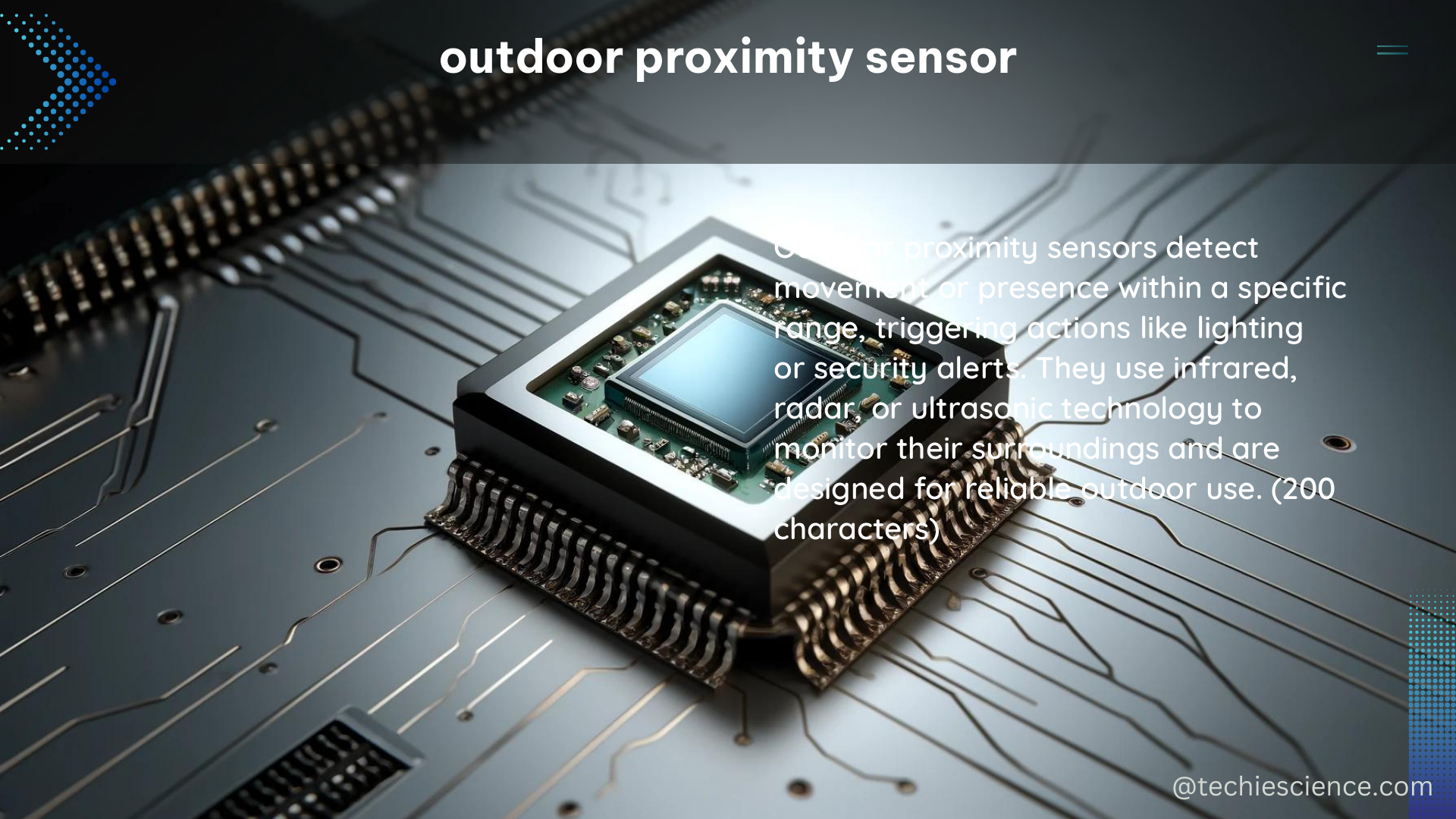Outdoor proximity sensors are essential for a wide range of applications, from home automation and security systems to industrial automation and smart city infrastructure. These sensors detect the presence of objects or individuals within a specific range and provide quantifiable data that can be used to trigger various actions or alerts. In this comprehensive guide, we will delve into the technical details, key features, and practical considerations of outdoor proximity sensors.
Detection Range and Sensitivity
One of the critical aspects of outdoor proximity sensors is their detection range. The Zooz outdoor motion sensor, for instance, has a detection range of up to 15 feet (4.5 meters). This range is crucial for determining the sensor’s placement and ensuring it covers the desired area. However, it’s important to note that the actual detection range can be influenced by various factors, such as the sensor’s sensitivity, environmental conditions, and the size and reflectivity of the target object.
Sensitivity is another important factor to consider when selecting an outdoor proximity sensor. Passive Infrared (PIR) sensors, which are commonly used in outdoor motion detection, can be susceptible to false positives due to changes in infrared radiation caused by factors like sunlight or moving vegetation. To address this issue, some sensors incorporate advanced algorithms or dual-technology approaches, combining PIR with microwave or ultrasonic detection, to improve sensitivity and reduce false alarms.
Received Signal Strength Indicator (RSSI)

The Received Signal Strength Indicator (RSSI) is a quantifiable metric used in proximity sensors to estimate the distance between devices. RSSI values indicate the strength of the signal received from a device, and they can be used to approximate the distance between the sensor and the target object. However, it’s important to note that RSSI values cannot be directly translated into equidistant increments, as they are influenced by various factors, including physical distance, signal strength, and environmental conditions.
Wireless Communication Protocols
Outdoor proximity sensors typically use wireless communication protocols, such as Zigbee, Bluetooth, or Wi-Fi, to transmit data to a central hub or controller. For example, the Bosch Tritech motion sensor mentioned in the Reddit post uses Zigbee for wireless communication. These protocols enable the sensors to seamlessly integrate with smart home systems, security networks, or industrial automation platforms, allowing for remote monitoring, data analysis, and automated responses.
Power Source and Durability
When selecting an outdoor proximity sensor, it’s essential to consider its power source and durability. Outdoor sensors should be weather-resistant and capable of operating in various environmental conditions, such as extreme temperatures, precipitation, and UV exposure. Additionally, the sensor’s power source is crucial, as some sensors may require frequent battery changes or have limited operating times, which can impact their reliability and maintenance requirements.
Technical Specifications and Considerations
When choosing an outdoor proximity sensor, it’s important to carefully evaluate its technical specifications and consider the following factors:
- Detection Range: Determine the required coverage area and select a sensor with an appropriate detection range.
- Sensitivity and False Positive Rate: Assess the sensor’s ability to accurately detect targets while minimizing false alarms.
- Wireless Communication Protocol: Ensure compatibility with your existing smart home, security, or industrial automation systems.
- Power Source: Consider the sensor’s power requirements and choose a solution that meets your needs in terms of battery life or wired power.
- Durability and Environmental Resistance: Verify that the sensor can withstand the outdoor conditions in your installation location.
- Integration and Compatibility: Ensure the sensor can seamlessly integrate with your desired control systems or software platforms.
Conclusion
Outdoor proximity sensors are essential for a wide range of applications, providing quantifiable data and enabling automated responses to the presence of objects or individuals. By understanding the key features, technical specifications, and practical considerations of these sensors, you can make informed decisions and select the right solution for your specific needs. Whether you’re working on a smart home project, a security system, or an industrial automation solution, this comprehensive guide will help you navigate the world of outdoor proximity sensors and ensure optimal performance and reliability.
References:
- Setting up a motion sensor – Home Assistant Community: https://community.home-assistant.io/t/setting-up-a-motion-sensor/468737
- Sensor-based proximity metrics for team research. A validation study …: https://www.ncbi.nlm.nih.gov/pmc/articles/PMC8062328/
- Wearable sensors for activity monitoring and motion control: A review: https://www.sciencedirect.com/science/article/pii/S2667379723000037
- Motion sensors that can be used outside? : r/homeassistant – Reddit: https://www.reddit.com/r/homeassistant/comments/uunjsb/motion_sensors_that_can_be_used_outside/

The lambdageeks.com Core SME Team is a group of experienced subject matter experts from diverse scientific and technical fields including Physics, Chemistry, Technology,Electronics & Electrical Engineering, Automotive, Mechanical Engineering. Our team collaborates to create high-quality, well-researched articles on a wide range of science and technology topics for the lambdageeks.com website.
All Our Senior SME are having more than 7 Years of experience in the respective fields . They are either Working Industry Professionals or assocaited With different Universities. Refer Our Authors Page to get to know About our Core SMEs.